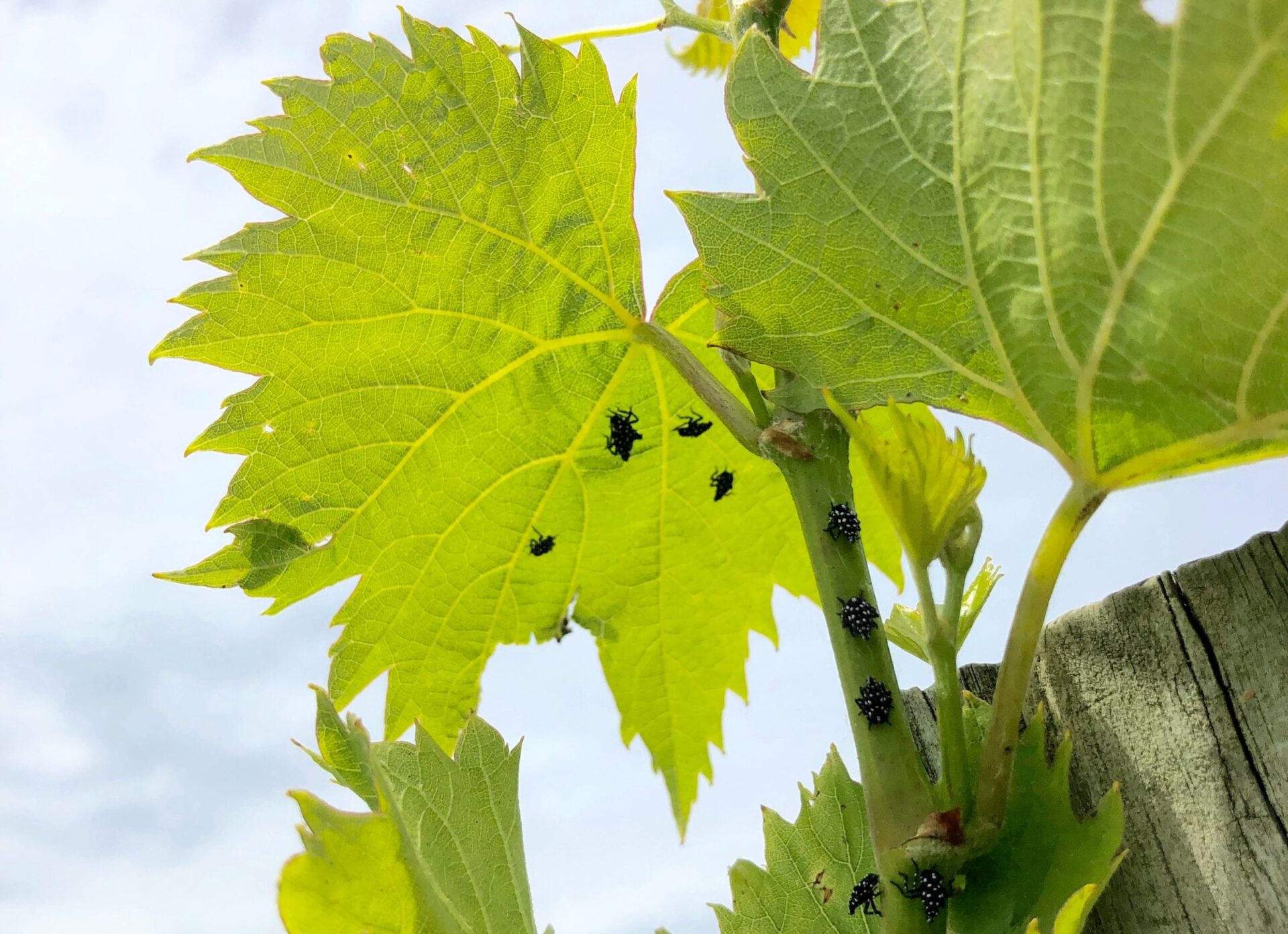It’s an ongoing issue with ongoing research. Here are the latest findings.
Making their way through the mid-Atlantic states and beyond, Spotted Lanternflies (SLF) damage about 70 varieties of plants, according to Penn State Extension including grapevines, feeding on the trunks, shoots, and leaves of the vines, gathering sap, removing nutrients, and being true pests.
“It’s not a good experience for a customer to come to the winery and stomp bugs on the ground before they even get through the front door,” says Sam Landis, partner at Vyncrest Vineyards and Winery in Breinigsville, PA. Vynecrest was an early winery affected by the SLF.
“The customers are sympathetic,” says Landis. “They come in and commiserate about the same problems they’re having in their backyard.” Still, it impacts the experience.

“For the past three years, we’ve been replanting one or two acres of vines that aren’t getting through the winter,” he says. While he can’t say for certain they were destroyed by the SLF, Vyncrest has grown grapes since 1974, and it’s just within the last three years, coinciding with the local SLF invasion, that this amount of acreage has started dying off
Vyncrest is working with the Penn State Extension to find solutions. While they’re grateful for the help, Landis says, “You never want to see a bunch of excited Penn State researchers coming out to your property.”
Eradicating the Spotted Lanternfly is highly unlikely at this point. Control is key, as
research is in efficacy trials, with scientists conducting in-field trials in several areas throughout several East Coast states.
Walls and Netting

“Grapevines are often bounded by woodland areas,” says Emelie Swackhamer, Penn State Horticulture Extension Educator. “There are a lot of situations where neighboring properties have trees [that] Lanternflies love.”
“When they become adults, they fly into the vineyard,” says Swackhamer. “We’re not 100 percent sure why. We believe they may have depleted the food sources in the woodland.”
Researchers are trialing barrier walls between vineyards and neighboring woodlands coupled with insecticide-lade netting surrounding vulnerable vines. But Swackhamer says the pests climb up those walls, launching off the top and into the vineyards. So, to further protect the vines, growers place netting with insecticide which catch the insects when they land.
In New Jersey, Unionville Vineyards is working with the New Jersey Agricultural Experimentation Station out of Rutgers on a similar experiment.
“Rutgers put up this net barrier on the edge of the outermost row, closest to the tree line,” explains John Cifelli, Unionville’s general manager. When the Lanternflies flutter down from the trees, they reach a net placed about two feet off the ground where they absorb the insecticide through their feet.

Another project Unionville is working on with Rutgers utilizing mesh traps on the surrounding trees where nymphs like to climb.
“When the nymphs walk up a tree they’re funneled into a holding tank,” says Cifelli. “We have caught thousands of nymphs this way.” Researchers from Rutgers collect any still-live nymphs from the traps further study.
Biological Control
In the U.S., there are no known predators likely to significantly reduce SLF population. Researchers are evaluating quarantined predators brought from the SLF’s native regions of Asia, but it’s unknown if those predators will gain approval for release.
But another biological control looks more promising.
“We have found fungi killing spotted lanternflies in wet years,” says Swackhamer. Penn State has been experimenting with Beauveria bassiana, but scientists haven’t done enough research to recommend the fungi.
Egg Destruction
Destruction of eggs can reduce the number of Spotted Lanternflies. Scraping the egg masses off trees and destroying them manually or with the chemical chlorpyrifos can reduce the number of SLF, but it won’t stop an infestation. “It’s a “fool’s errand,” comments Cifelli
Spraying
“Spotted Lanternflies are not hard to kill with insecticides,” says Swackhamer. Spot treatments for nymphs can be effective and there are several insecticides that will kill adults.
Vineyards that choose insecticides need a management strategy. Since the adults often appear close to harvest, the residual effects of the insecticide must also be factored. But, since spotted lanternflies tend to predominantly inhabit edge-row vines, the whole vineyard may not need spraying.
While researchers are still looking for ways to control the lanternflies, as Landis comments, “Everyone is pretty much resigned to the fact that this is something that is dealt with and not handled,” says Landis.
—Robin Shreeves
_______________________________________________________________________

Robin Shreeves is a drinks journalist and lifestyle features writer. Her wine writing has appeared in dozens of print and online publications including Wine Enthusiast, VinePair, Courier Post, Spirited magazine, Edible Philly, Edible Jersey, USA Today, and Drink Philly. She holds a Level 3 wine certification and Advanced Wine Speaker certification from the National Wine School. Robin is also cofounder of Thinking Outside the Bottle that offers content writing for drinks brands.




